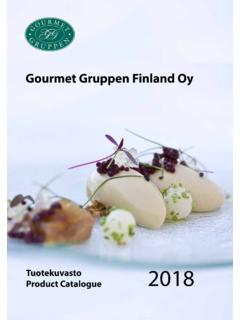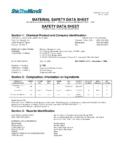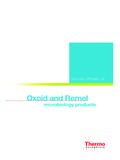Transcription of G TANDARD ESTING ETHODS - GMIA
1 GELATIN. STANDARD TESTING METHODS. MANUFACTURERS. INSTITUTE OF FOR EDIBLE GELATIN. AMERICA. Official Procedure of the Gelatin Manufacturers Institute of America, Inc. Revised July 2013. GMIA STANDARD METHODS FOR THE TESTING OF EDIBLE GELATIN. TABLE OF CONTENTS. 1. General Information Definition Description Stability Functionality Characteristics Identification Hydroxyproline Content Sampling 2. Physical / Chemical Testing Gel Strength Viscosity Moisture pH. Granulation Ash Sulfur Dioxide Clarity Official Procedure of the Gelatin Manufacturers Institute of America, Inc. Revised July 2013 Page 1. GMIA STANDARD METHODS FOR THE TESTING OF EDIBLE GELATIN. TABLE OF CONTENTS. Continued 3. Microbiological Testing Total Aerobic Count E. coli Salmonella Official Procedure of the Gelatin Manufacturers Institute of America, Inc. Revised July 2013 Page 2.
2 GMIA STANDARD METHODS FOR THE TESTING OF EDIBLE GELATIN. Preface The Standard Methods for the Sampling and Testing of Edible Gelatin contained in this booklet are the results obtained by a co-operative testing program conducted by the Technical Staffs of the entire membership of the Gelatin Manufacturers Institute. These methods have been found to give accurate and consistent results. 1. General Information Definition Gelatin is the product obtained from the acid, alkaline, or enzymatic treatment of collagen, the chief protein component of the skins, bones, and connective tissues of animals, including fish and poultry. These animal sources shall have not been exposed to pentachlorophenol. Type A gelatin is produced by the acid processing of collagenous raw materials and exhibits an isoelectric point between pH = 7 and pH = 9. Type B gelatin is produced by the alkaline or lime processing of collagenous raw materials and exhibits an isoelectric point between pH = and pH = Mixtures of Types A.
3 And B as well as gelatins produced by modifications of the above mentioned processes might exhibit isoelectric points outside of the stated ranges. (Food Chemicals Codex). Description Gelatin is nearly tasteless and odorless. It is a vitreous, brittle solid that is faintly yellow to light tan. It is supplied in various physical forms such as coarse granules, fine powders and leaves. Stability Gelatin is very stable when stored in its original container in ambient humidity with controlled temperature. The shelf life of gelatin is generally recognized as stable for at least 5 years when stored under these conditions. Functionality in Foods Gelatin is used in confectionery, water jellies and desserts, dairy products or functional food, for its versatility. Its functionalities include firming agent, formulation Official Procedure of the Gelatin Manufacturers Institute of America, Inc.
4 Revised July 2013 Page 3. GMIA STANDARD METHODS FOR THE TESTING OF EDIBLE GELATIN. and processing aid, stabilizer and thickener, surface-active agent, and water finishing agent. Characteristics When gelatin granules are immersed in cold water, they hydrate into discrete, swollen particles. On being warmed, gelatin disperses into the water, resulting in a stable suspension. Water solutions of gelatin will form a reversible gel if cooled below the specific gel point of gelatin. The gel point is dependent on the source of the raw material. Gelatin extracted from the tissues of warm-blooded animals will have a gel point in the range of 30 C to 35 C. Gelatin extracted from the skin of cold-water ocean fish will have a gel point in the range of 5 C to 10 C. Gelatin is stable in aqueous solutions of polyhydric alcohols such as glycerine and propylene glycol.
5 It is insoluble in most organic solvents (Food Chemicals Codex). Identification Principle Gelatin can be identified by a visual, physical state change; formation of a precipitate or turbid solution; and determination of hydroxyproline content. Reagents and Solutions 1. Dry, granular gelatin 2. Deionized water 3. Trinitrophenol TS. 4. Potassium dichromate solution 5. 3N hydrochloric acid Apparatus 1. 100 mL volumetric flask 2. Water bath 3. Refrigerator Procedure 1. Gelatin forms a reversible gel. Official Procedure of the Gelatin Manufacturers Institute of America, Inc. Revised July 2013 Page 4. GMIA STANDARD METHODS FOR THE TESTING OF EDIBLE GELATIN. A. Dissolve 10 g of gelatin in 100 mL hot water. When all gelatins are dissolved, place the solution in a refrigerator (2-10 C) for 4 hours. Gelatin gels. B. Remove the gelled solution and place the container in 60 C.
6 Within 30. minutes, when stirred, the gel reverts to the original liquid state. 2. To a 1:100 aqueous solution, add trinitrophenol TS or a solution of potassium dichromate (1:15) previously mixed with its volume of 3N hydrochloric acid. A. yellow precipitate forms. 3. For conclusive evidence of identity, test for hydroxyproline Hydroxyproline Content Principle Gelatin contains a high amount of the amino acid hydroxyproline. Hydroxyproline is liberated through acid hydrolysis, oxidized, and then identified with Erlich's reagent (5% p-dimethylaminobenzaldehyde in n- propanol). Reagents and Solutions 1. CuSO4. 2. NaOH. 3. 6% H2O2. 4. 3N H2SO4. 5. Erlich's Reagent 5% p-Dimethylaminobenzaldehyde in n-Propanol (make fresh each time). Apparatus 1. Oil bath, capable of 145 C. 2. Water bath, 40 C. 3. Ice bath 4. Bunsen burner 5. 18 x 150 mm test tubes 6.
7 500 mL volumetric flask 7. Aluminum foil 8. Distilled/deionized water 9. Concentrated HCl Official Procedure of the Gelatin Manufacturers Institute of America, Inc. Revised July 2013 Page 5. GMIA STANDARD METHODS FOR THE TESTING OF EDIBLE GELATIN. Procedure 1. Dissolve gram of material in 200 mL of water. 2. Add 3 mL of this solution and 3mL of conc. HCl to an 18 x 150 mm test tube. Seal by melting the top in a Bunsen burner. Hydrolyze at 145 C for hours in an agitated oil bath. 3. Cool the hydrolysate, cut off the top of the tube, transfer contents to the volumetric flask and dilute to 500 mL. 4. Transfer 1 mL to an 18 x 150 mm test tube. Add 1 mL CuSO4, 1 mL. NaOH, and place in a 40 C water bath for 5 minutes. 5. Add 1 mL 6% H2O2 and mix immediately. 6. Keep the sample at 40 C for 10 minutes, Shake and rotate to remove all excess H2O2.
8 7. Cool rapidly in an ice bath. Add 4 mL 3N H2SO4, mix, then add 2 mL Ehrlich's reagent, mix, cover with aluminum foil and hold at room temperature for 15. minutes. The development of an intense red color shows the presence of Hydroxyproline. Quality Control All chemicals are reagent grade. Sampling Principle Aseptic gelatin samples are required for all testing. The square root method plus one, should be followed to determine the number of samples per lot. Reagents and Solutions None Apparatus 1. Sterile gloves 2. Scoop 3. Air - tight container Official Procedure of the Gelatin Manufacturers Institute of America, Inc. Revised July 2013 Page 6. GMIA STANDARD METHODS FOR THE TESTING OF EDIBLE GELATIN. 4. U. S. standard sieve (8 mesh). 5. Table top blender Procedure 1. Take aseptic sample by scooping out a cone several inches below surface of the gelatin in the container.
9 2. Pull the scoop up, across the vertical surface of the cone to obtain a representative sample. 3. Place samples as drawn in clean airtight containers. 4. Proportion the amount taken from each container selected to at least 120g of sample per container. 5. Blend or mix samples thoroughly. 6. Withdraw and retain at least 500g as the final sample. Note: Gelatin coarser than 8 mesh standard sieve should be ground so that all particles pass the 8-mesh sieve. The entire final sample should be re- blended. 2. Physical / Chemical Testing Gel Strength Principle The gel strength of gelatin is a measure of the rigidity of a gel formed from a solution and prepared according to certain arbitrary prescribed conditions. Bloom is a measure of force (weight) required to depress a prescribed area of the surface of the sample a distance of 4 mm.
10 Apparatus 1. (Texture Technologies) or LFRA (Brookfield Engineering) Texture Analyzer AOAC plunger, diameter, sharp edge (not beveled). 2. Automatic pipette, water capacity g at 25 2 C. The delivery rate should be 105 g of distilled/deionized water in 15 seconds. 3. Stir rods, stainless steel or brass, approximately 3 mm diameter and 15 cm in length and tapered at one end. Official Procedure of the Gelatin Manufacturers Institute of America, Inc. Revised July 2013 Page 7. GMIA STANDARD METHODS FOR THE TESTING OF EDIBLE GELATIN. 4. Bloom jar (available from Schott or Brookfield Engineering): capacity 150 mL, overall height 85 mm, inside diameter 59 mm, outside diameter 66 mm, neck inside diameter 41 mm, shoulder height 65 mm. All linear dimensions are . mm. Bottle must have flat bottom to ensure it does not rock on a flat surface.







